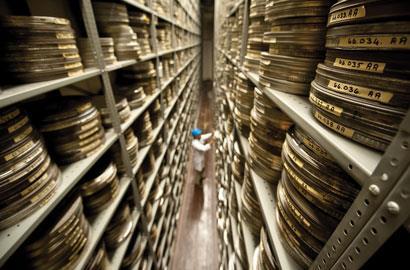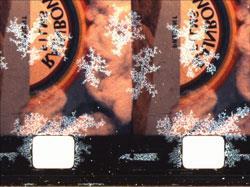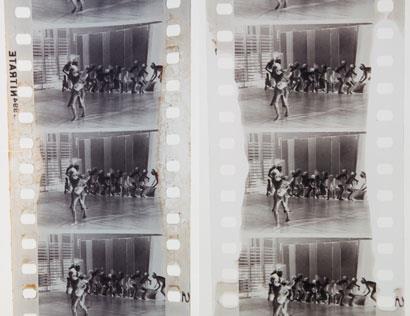Emma Davies unreels the blockbuster tale of film preservation
Emma Davies unreels the blockbuster tale of film preservation
Another Christmas, another family film ’for the record’. Over the years the recordings chart the emergence of wrinkles, the receding of hairlines and changing fashions. Yet how should you store such footage so that your great grandchildren can laugh at it in years to come?
Computer hard drives fail and newly-burned DVDs will only reliably hold information for three to five years, says Leo Enticknap from the Institute of Communications Studies at the University of Leeds, UK. For decades, archivists have made analogue copies of film by photographing it onto new film. ’Now there is a great debate raging as to whether we should continue to do this or whether the best way forward might be to make a high resolution digital scan,’ explains Enticknap. The problem is that there is currently no reliable way to store digital data for centuries in the way that film can be stored.

Current digital recording devices will soon be replaced by the next must-have technology and it is highly likely that future generations will be unable to view recordings, if indeed they have survived that long. In centuries to come a basic analogue film-reading device could easily be thrown together.
Archivists are advised to re-record digital films every five years or so to ensure that they remain readable, in a process known as format migration. ’Preserving digital is a bigger headache than preserving film, which is why we want to continue preserving original archive on film for as long as possible,’ says Enticknap, who is also a director of the board at AMIA (Association of Moving Image Archivists).
Russ Suniewick, cofounder of Colorlab, a US film company specialising in archives and preservation, feels strongly that transferring to digital format is not preservation at all. ’It must be put onto another film. The most permanent is polyester film which has a reported life of 1000 years.’
Yet film storage in controlled cool, dry and dark conditions is expensive and archives are already bursting at the seams. Preserving original film recordings is the ’mainstay of preservation practice’, says Enticknap. They are only copied if they show signs of deterioration. Many valuable early recordings dating back to the 1890s are on cellulose nitrate films which are not only highly flammable but also susceptible to dramatic decay. According to Unesco estimates, over two billion nitrate films are currently stored in archives around the world.
Nitrate films were used until 1951 in the US and about 144 000 cans of them are stored at the Packard Campus for Audio Visual Conservation, a converted cold war bunker in the foothills of the Blue Ridge Mountains in Culpeper, Virginia, US. There, the US Library of Congress houses a 6.3 million piece collection of audio, moving image and film materials.
When films decay, the process can be very sudden, says Ken Weissman, supervisor of the film preservation laboratory at the Packard Campus. ’You can have a film that seems from appearance to be fine for months. Six months later it is almost completely gone.’ The decay is worse for nitrate films. Staff at the campus inspect all of the nitrate archives at least once a year looking for signs of decay and sniffing for any tell-tale acid odours.
Nitrate nightmare
Films have three basic layers: a transparent base (eg cellulose nitrate), a binding layer which helps the emulsion to stick to the base, and a gelatine emulsion containing the image material (silver or dye). The film is then coated with a slightly tougher gelatine layer.
The only polymer types to have made successful base materials are the cellulose esters (cellulose acetates and nitrates) and polyester.
Cellulose nitrate, a high quality clear plastic, at first appeared to be a perfect film base. It was originally made by nitrating a cotton byproduct using nitric and sulfuric acids. The cellulose polymer was then dissolved in plasticiser solvents such as camphor and cast on a highly polished flat surface.
Yet the flammable cellulose nitrate burns fiercely to give a thick, toxic smoke containing nitrogen oxides and carbon monoxide. With its readily available nitro groups, cellulose nitrate does not need atmospheric oxygen to burn and its fires have been described as ’impossible’ to put out.
A series of catastrophic nitrate film fires at the turn of the 20th century led the industry to develop safer alternatives. From the 1910s, cellulose acetates became available as ’safety’ films. Initial cellulose diacetates were not quite stable enough and the more stable and durable cellulose triacetate was introduced commercially in the late 1940s as solvents became more available after the second world war. The tough and chemically stable polyester film base was not used on any significant scale until the late 1980s. ’Even today it cannot always be used to create preservation materials,’ says Enticknap.
Sticky honeycomb
Polyester is pretty stable under normal conditions, although it can become too rigid. Unfortunately, cellulose acetate films are as prone to decay as nitrate films under less-than-perfect storage conditions.
Almost two decades ago Michele Edge, a polymer chemist at Manchester Metropolitan University, UK, worked on a project with the British Film Institute, Eastman Kodak, and George Eastman House in Rochester, US, in a bid to understand the decay. ’We started off with nitrate materials because that’s where there were most of the problems,’ she recalls. ’A lot of the nitrate film was congealing into a honeycomb-like mess, oozing sticky substances and giving off an acrid vapour. People didn’t know why it was happening.’ At the same time, cellulose acetate films were also landing on her desk for analysis.

’Nitrate film can deteriorate by hydrolysis or by some thermal mechanism that as yet no one agrees on,’ explains Douglas Nishimura from the Image Permanence Institute in Rochester, US. What is clear is that the more humid and warmer the atmosphere, the faster the hydrolysis and decomposition. Nitro groups cleave from the cellulose backbone and the nitrogen oxides can then react with water to give nitrous and nitric acids. In the early stages of decay, nitric acid converts silver in the image layer into a colourless silver salt - probably silver nitrate - causing film fading. The degradation soon becomes autocatalytic as the acids induce secondary reactions in the cellulose nitrate base and emulsion layers. Iron in the film cans and magnetic soundtracks also catalyses decomposition.
The acids are thought to digest the cellulose into a series of sugar-like compounds known as ’nitrate honey’ which bubble up to the reel surface. Eventually the decaying film becomes a solid, sticky mass before disintegrating into a brown powder.
Vinegar syndrome
Cellulose acetate films undergo a similar decay, but this time the villain is acetic acid and the process has been dubbed ’vinegar syndrome’. Although acetic acid will not affect the silver, it can soften the gelatine in the emulsion and damage the images. Edge has even seen some cases where acetic acid has reacted with aluminium in the film can to give aluminium acetate.

The acetate hydrolysis is acid - as well as alkaline - catalysed, says Nishimura. ’For each acid molecule entering the reaction as a catalyst, two acid molecules come out,’ he says.
As the cellulose chains are shortened by the acid reaction and the plasticiser migrates to the surface, the film base shrinks and becomes brittle. When this happens, the emulsion layer can start to shear away from the base.
The increased acidity also makes the gelatine more positively charged and attractive to the plasticisers. These form solid layers bound to the gelatine and the film soon becomes a ’solid blocked mass’, according to the Australian National Film and Sound Archive (NFSA).
What to do?
Cold storage, with low relative humidity, is a very effective way to prevent film decay and colour fading. These conditions also inhibit mould, mildew and fungus growth.
Archives around the world have built cold storage facilities. The British Film Institute has ploughed ?12 million into building a new UK film storage facility in Gaydon capable of storing 450 000 cans under controlled conditions of -5?C and 35 per cent relative humidity.
Yet the films need to be in a very good condition before entering cold storage to prevent decay. ’There is no indication that we will ever find a way to arrest decomposition once it has started. All we can do is inhibit it,’ says Enticknap.
Decomposing films need to be copied as soon as possible. This often requires some careful preservation work to get the film to a state where it can be copied. ’When vinegar syndrome starts to show up we need to take significant intervention,’ says Weissman. This can mean freezing the film or washing it to lower the acidity. When it comes to washing, great care needs to be taken because the gelatine, which also hydrolyses during decay, will readily soak up water. ’The more badly deteriorated a film is the greater the risk that a water soak will cause the gelatine binder to dissolve in the water or to slide off the base, taking the image with it,’ says Nishimura.

Meanwhile, blocked film can be dealt with using solvents to dissolve the plasticisers. ’At Colorlab, if a film is stuck together we have a system where we expose the film to vapours of the same chemical constituents as the plasticiser to get the film in a condition where it can be unwound and reproduced,’ says Suniewick. ’There’s always a lot of risk involved,’ he adds. ’It is easy for the film to over-react and for the emulsion to separate from the base. The chemical reaction taking place must be monitored constantly.’
Re-record
If you have any cellulose nitrate film at home the UK Health and Safety Executive advises contacting a film archive as a matter of urgency. ’On no account should cellulose nitrate film be sent by post, carried on public transport or disposed of as refuse,’ shouts a HSE leaflet. NFSA recommends copying all cellulose nitrate film, keeping only negatives in good condition.
It is sometimes possible to strip the emulsion from the base and transfer it to a new stable one. Meanwhile, machines are available to copy negatives onto new film. Here, improvements can be made and scratches removed. So-called wet-gate and immersion printers have made a huge difference to the world of film preservation, allowing almost perfect copies to be made from scratched films. The damaged film is immersed in liquid perchloroethylene to fill in scratches and surface imperfections. The chemical has a similar refractive index to the film base and renders the scratches invisible while copies are made.
Archivists make a clear distinction between preservation and restoration, which can be more subjective. Should the film be restored to its original condition and if so is it clear what is original? Or should the original film be touched up and ’improved’ for modern audiences? When Robert Harris and James Katz restored Alfred Hitchcock’s Vertigo to give it a new digital stereo soundtrack, together with some re-recorded sound effects, they attracted both praise and criticism.
Digital direction
Diamant is a digital film restoration project run by Joanneum Research, an Austrian technology provider. It has developed algorithmic solutions for different defects and can ’eliminate practically all undesirable signs of decay and ageing’ in films. The software can allow for a basic preservation or a more ’aggressive’ restoration, says Georg Thallinger at Diamant. ’Normally it is easier to do more of an archival restoration. From there you could take a second step to create a more viewer friendly version,’ he says. Such restoration allows old gems to be shown in the digital cinemas that are rapidly becoming the norm. ’What has kept us busy is that resolutions used for digitising film are getting higher and higher,’ says Thallinger.
Unfortunately, the cinema switch to digital means that ’the manufacture of film is rapidly dying out’, warns Enticknap. AMIA’s preservation committee is currently lobbying film makers ’not to discontinue the manufacture of certain types of film stock that are absolutely vital to preservation work’, he says . ’It appears likely that within three to four years the film stocks needed to make archival preservation copies will no longer be routinely manufactured. This is starting to be a major issue for achivists.’ Furthermore in November, Kodak - which manufactures around 90 per cent of the world’s photographic film - reported financial difficulties. The company is, however, keen to reassure worried achivists: ’Kodak continues to invest in R&D towards expanding their archival film products,’ their spokesperson told Chemistry World.
Enticknap himself still takes all his personal photographs on film to ensure that they last. ’Assuming that it can be protected from chemical decomposition, a film can always be scanned again whenever needed. An original digital file cannot,’ he says. As for those family videos, perhaps we are better off without them.
Emma Davies is a science writer based in Bishop’s Stortford, UK







No comments yet